Liz and I have begun the long drive back to Cairns, about to cross the famed
Nullarbor Plain. (I wish we had a plane). It’s chilly and a bit rainy but
our spirits are still soaring from a wonderful experience with four species
of albatross. This weeks article is on the rather unlikely group of parrots that reign in Australia. They are amazing in their color, variation and ecology. Enjoy!
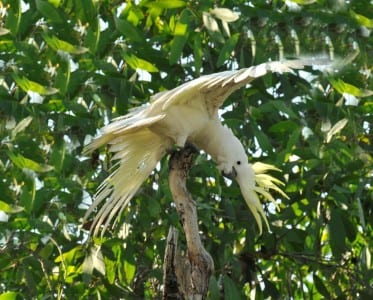
Probably the queen of the Australian parrot order is the Sulfur-crested Cockatoo. It is one of the white, large parrots; it’s very adaptable and widespread and is frankly, extremely loud. Their yellow crest helps separate them from several species of white corellas and they are bigger as well. Cockatoos seem to be more expressive than other parrots and this one is striking quite a pose.
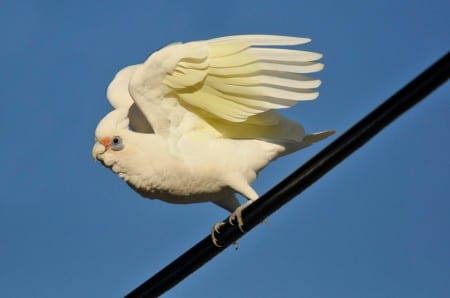
While there are black cockatoos, the most similar to the Sulfur-crested is the various species of corellas found in the far corners of Australia. This is the Western Corella, about to take flight. Note the sulfur in the wings and the bare, blue skin around the eye. Corellas are smaller than cockatoos but still, mighty danged loud.
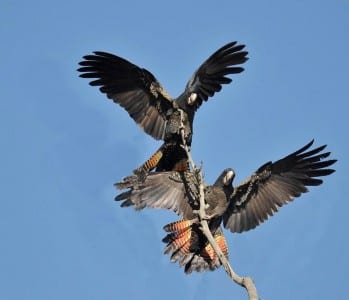
Two female Red-tailed Black Cockatoos are appearing to be waving at us, and they are really part of a flock with several dozen. Many non-migratory birds have wings that are more squared than pointed, a tribute to their absence of long flights. They climb around using their feet but also employ their bill as a third grasping tool. They also don’t seem to be terribly concerned by most raptors and I imagine they’d be a real battle for a kite.
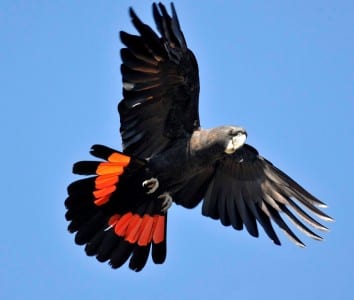
Male RTCs have redder tail patches and blacker feathers. You can also see the zygodactyl toes – two in front and two in back. All parrots have this feature and, along with woodpeckers, it helps them climb on bark easier (and hold objects). These are stout birds with great strength. And did I mention how LOUD they were?
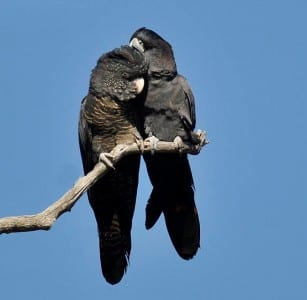
All grooming is common in certain tropical families, especially those with strong social habits ,like babblers. Here the male picks cooties out of the female’s hair. (That is surely the most UN-scientific thing I have ever written).
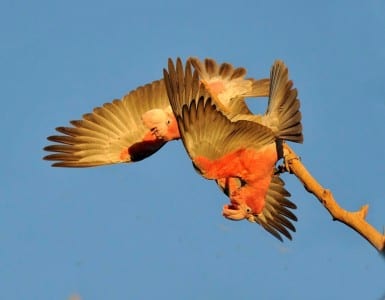
Galahs are nearly as large as corellas and nearly as loud, too. They are curiously pink and show up on peoples’ lawns right in cities. But also, far in the Outback, you are just as likely to see Galahs walking roadsides, picking up food stuffs. They eat a lot of nuts, seeds and fruit, plus odds and ins they unearth.
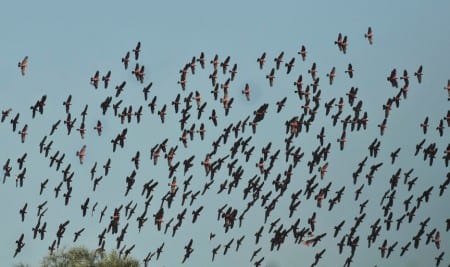
As you can see, Galahs are abundant and these birds were flying over an agricultural setting near dusk. There were several hundred and the noise was ear-splitting. Many birds like Galahs are virtually continent-wide because their habitat doesn’t change that much throughout the Interior.
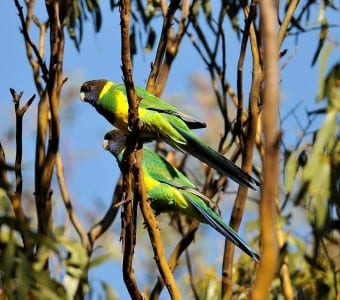
In addition to the aforementioned parrots, Australia has several long, hefty species like these Pt. Lincoln Parrots. These live in the southern portion of the country and have several different color morphs (collectively called “ring-necks”). Liz photographed one right on the coast called “28” (not yet named) and it has a red cere. (I am not exaggerating in the least when I say SHE gets ALL the good shots).
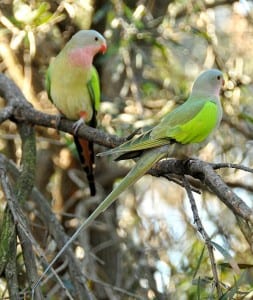
In a stroke of unbelievable luck, we got shots of the extremely rare Princess Parrot of the scrubby deserts. With the (out of focus) male matching his bill and thighs, as well as his throat and under-tail retrices, they look like they were designed by a New York fashion designer. Even I never dreamed of getting this species.
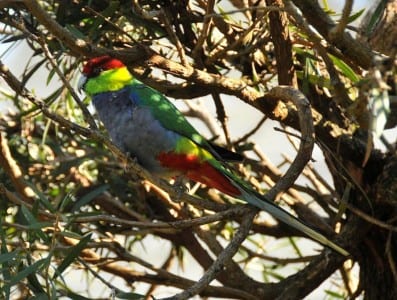
High up in the world-champion Tingle Trees sat life bird 5985, the Red-capped Parrot. These are the third-tallest trees on Earth and these parrots zipped up through the canopy like it was child’s play. There are quite a few birds “endemic” to SW Australia and these are the kinds of areas life birds abound. Liz is well over 300 new birds on this trip. She will likely surpass a thousand species since we met late last August in Arizona.
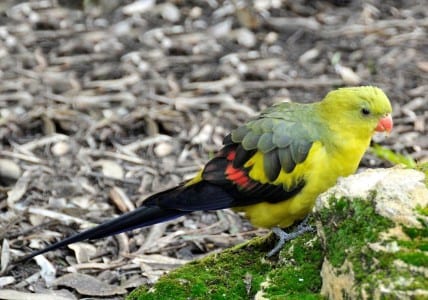
The Regent Parrot is just such a bird, only found in extreme SW Oz, and not an especially common bird, either. This bird was eating moss off a rock and like many parrots, was tame and abiding. I saw other parrots doing this as well. Regents are fast-flying parrots that are not as noisy as many species.
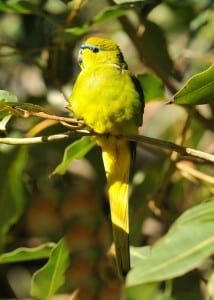
The uncommon Rock Parrot is only found in the SW and around Adelaide, and is also a great find. It’s funny how well green can “go” with blue.
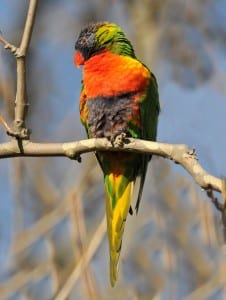
An extremely widespread and abundant Aussie parrot is the Rainbow Lorikeet, as common in the dry Outback as it is in cities. These come to feeders in many places and are a big favorite among the Australians. They know their birds better than the average American does, perhaps partly because of the amazing city birds they have in their back yards!
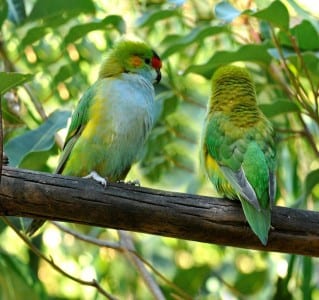
Purple-crowned Lorikeets are found along the southern coast of Australia and are uncommon and shy. As usual, I got lucky, near habitation. They are neither as large as the Rainbow Lorikeet nor as loud but all parrots can be quite vocal and conspicuous. Look for these in moist forests near the Southern Ocean.
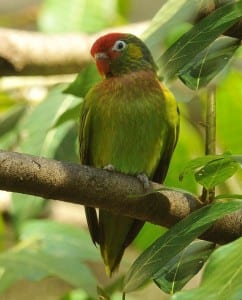
Varied Lorikeets are at the opposite end of the Continent, across the northern edge of Oz. They camouflage very well in the canopy and when quiet is the devil to find. Kakadoodledoo National Park is a great place for them and we got them several times. In all honesty, I don’t know exactly what makes a lorikeet a lorikeet.
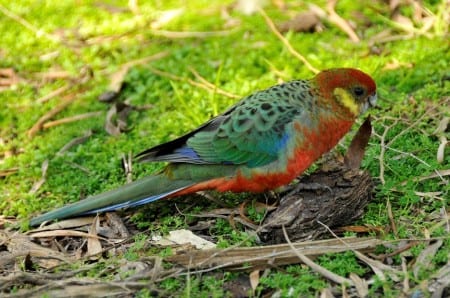
Rosellas are about the same size as Lorikeets and different species seem to be found in each corner of Oz. These Western Rosellas are quite red underneath but vanish on the forest floor when they turn their back. Few can match the Crimson Rosella of the East, currently out of our range.
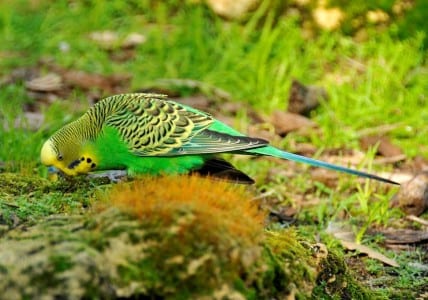
Another widespread parrot is the tiny Budgerigar, an abundant species of the Outback. Parrots spend more time on the ground and this one is chewing liverworts. As you know, this species has been the target of selective breeding by bird fanciers, producing about every colored “Budgie” imaginable. You do not see those in the wild!
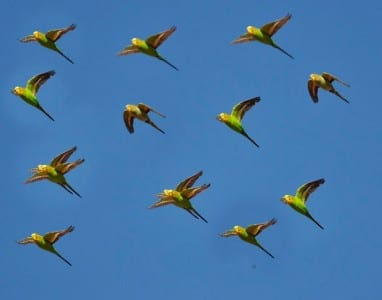
One of the more amazing things I’ve seen in Australia was literally thousands of Budgies flying south down the Aussie coast at Broome. Broome is about 8 o’clock on the Continent. It was looking like so many circum-Gulf migrants. One might interpret them as fall migrants heading south, but of course, it’s winter here, and spring’s next… 😉

 Posted in
Posted in 























